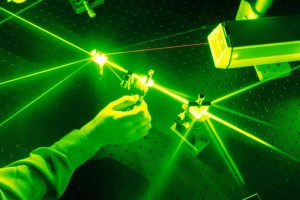

It is important for an optical designer to pay close attention to the characteristics of an optical coating with respect to those of the intended source of irradiation. While not usually an issue with most low-power consumer lasers, higher-powered lasersused in the optics, imaging, and photonics industries can lead to coating failure due to absorption sites or plasma burn. Optical designers and manufacturers can take steps to avoid such failures by carefully choosing an appropriate coating material, keeping a clean coating environment, and then testing the optical element for a given energy threshold specification.
Testing High-Power Optical Coatings
Testing facilities offer a variety of tests that can determine the quality of a certain optical coating - from surface roughness and optical density to environmental exposure. For the purpose of this discussion, only the two methods of testing laser damage durability will be discussed:
1. Damage Threshold Test - The optical coating is tested by irradiating the surface with a laser and increasing the output power until damage is observed.
2. Durability Certification - The optical coating is tested according to a pre-determined specification or combination of specifications. Possible testing parameters include pulse rate, pulse duration, pulse count, irradiance, and/or beam diameter. The optical coating passes inspection only if it meets or exceeds the requirements set by the customer or manufacturer.
Coating Failure Factors
Coating technicians carefully monitor the effects of varying a number of testing parameters when testing high-power optical coatings. These same parameters are therefore important to optical designers when attempting to prevent laser damage. The following characteristics represent a few of the many parameters that can affect the laser-induced damage threshold (LIDT) of an optical coating:
• Pulse Characteristics:
Duration - a measure of the length of an individual laser pulse. This measurement is not as straightforward for non-rectangular pulses and is given as the full width of the pulse at half the maximum intensity (FWHM). LIDT values decrease exponentially as temporal pulse duration increases.
Shape - the temporal shape of the laser pulse. Research has indicated that different shapes do have an impact on optical damage. For example, a rectangular pulse will result in coating damage at approximately 80% of the irradiance of a Gaussian beam with the same FWHM.
• Beam Characteristics:
Mode of operation - transverse electromagnetic (TEM) wave patterns. LIDT values are much lower for multimode lasers as opposed to single mode lasers.
Wavelength - the wavelength of the laser source. LIDT values decrease as the wavelength decreases.
Intensity distribution - the distribution of energy intensity over the width of the beam.
Angle of incidence - the angle at which the beam is deviated from the surface normal. LIDT values increase for increased values of angle of incidence due to increased reflection.
Spot size - the size of the beam on the surface of the coating. This measurement is taken using the full width of the beam at 1/e² intensity, where e is the maximum intensity value. LIDT values decrease as spot size decreases.